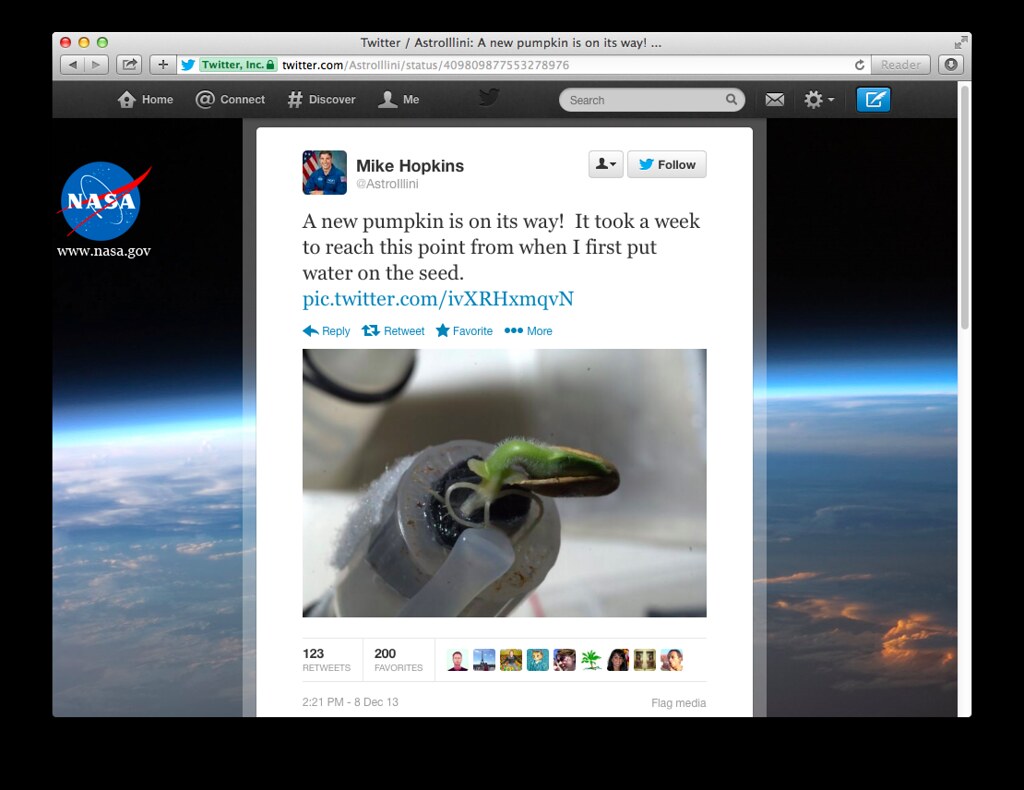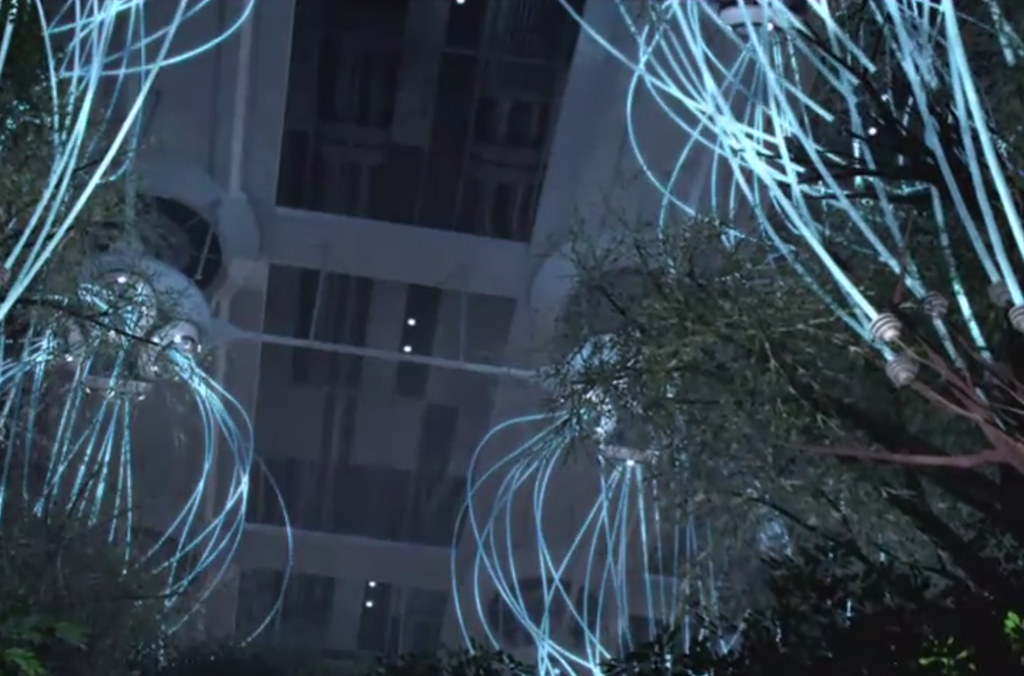With almost 39,000 followers, NASA Astronaut Mike Hopkins has an active social community on Twitter. He posts photos from the International Space Station, where he currently lives. The images in his tweets share his unique view from space looking over deserts, city lights at night, the thin layer of atmosphere; events like spacewalks; and other phenomenal encounters. His excited captions reflect awe and wonder at each of these new sights and experiences. On a photo of a space walk he wrote: “Wow…can’t believe that is me yesterday. Wish I could find the words to describe the experience, truly amazing .” Regarding a view of the Sahara: “I never thought the desert could be so beautiful.”
His posts also reveal insights and experiences that are other-wordly such as this tweet on September 30: “Did you know space has a smell? Before ISS hatch to Cygnus was opened, small area between vehicles was at vacuum which left a distinct odor.” Who wouldn’t be in awe of this experience? And as a follower on twitter, it’s incredible to be able to share in discoveries like this. I never would have imagined I would receive a firsthand report on the smell of outer space.
I was also fascinated to find that followers are able to watch Hopkins’ relationships with plants through his Twitter account. Since arriving on the station, he has been growing sunflower and pumpkin seeds, and posting updates on the results:
Starting out in ziplock bags, like elementary school science experiments, these sprouts are later shown after being transferred into more complex containers, presumably modules designed specifically for plants in space. But as you can see in the very first photo at the top of this post, these containers don’t contain them – the roots reach out, looking for more.
In a NASA book from 1977, “Space Settlements: A Design Study”, the authors analyze possible roles for plants in a speculative future of human space habitation. Chapter 3 “Human Needs in Space – Appendix A: Psychological and Cultural Considerations” describes plants as a necessary component for the psychological health of humans living in space, especially in preventing the dream-like state of “solipsism syndrome.” Plants are important in this regard, the authors note, because they are to some degree outside the control of humans; they do things that are unexpected:
“The Solipsism Syndrome in Artificial Environment
Some environments are conducive to the state of mind in which a person feels that everything is a dream and is not real. This state of mind occurs, for example, in the Arctic winter when it is night 24 hr a day. […]
This state of mind can be easily produced in an environment where everything is artificial, where everything is like a theater stage, where every wish can be fulfilled by a push-button, and where there is nothing beyond the theater stage and beyond an individual’s control.
There are several means to alleviate the tendency toward the solipsism syndrome in the extraterrestrial communities: […] 3. Something must exist which grows. […] It is important for each person to feel able to contribute personally to something which grows, that the reality often goes in a direction different from expectation, and finally that what each person takes care of may possess increased wisdom, and may grow into something beyond the individual in control […] it is important personally to raise children, and to grow vegetables and trees with personal care, not by mechanical means. It is also desirable to see plants and animals grow, which is facilitated by a long line of sight.” [Johnson 1977:29]
Hopkins’ documentation and sharing of his experience growing plants is also accompanied by this unexpected dimension – and one form of that is their occasional failure to survive. In this post, he explains that one of the pumpkin seeds has mysteriously begun to die:
But Hopkins tried again, starting a new seed.
As a follower on twitter, I see Hopkins’ updates about these plants. I see the photos of them sprouting, struggling to break through the seed shell, to grow and thrive, or not. I can’t help feeling there’s something heroic and sad all at once about these small packages of life from Earth, brought into the vacuum of space where they seemingly have no future. Looking at these images I first though how hopeless the plants appear, seemingly tricked into emerging, into living in a place they don’t belong. And if they did thrive, I wonder, how long would they grow on the ISS? Would they be cared for? Allowed to live?
In my own home here in New York I have houseplants that I care for. These plants, isolated in pots of soil, within my apartment many floors above the ground, in the concrete canyons of Manhattan – aren’t that different from those in the space station. Both are disconnected from the Earth, the ecosystems of the soil, but dependent on it and products from the planet underneath. Many of my plants are also cuttings from friends or colleagues – so they are continuations of plants that have been in workplaces or homes of others. They may never have known anything more than potting soil. Could the same thing happen in space? Assuming the plants Hopkins is growing can thrive, would they be accounted for in calculations of the atmosphere in the station? Would they take up resources or contribute? I wonder also: How big could they get? Would they be in the way? They seem to have the same precarious relationship with survival that house and office plants do, they depend on care, on human attention for survival - but they are also threatened by it as we control (or attempt to control) their growth and reproduction – decide whether to care for them or not, and where they will be in the home.
I wonder, are Hopkins’ space plants destined to live or die? What will human relationships with plants in space become?
In speculative fiction plants have played a pivotal role in human survival: as oxygen gardens for long term space voyages (Sunshine, 2007) and as cyborg forest oxygen factories in spaceships (Doctor Who, 2010).
But in today’s actual world of first steps into space habitation, the role is reversed. Humans care for plants and the plants live or die in their hands – like those under the care of a botanist living in space in the 1972 film Silent Running. On a small station such as the ISS, I wonder: what role do these plants play aside from that as subject in scientific experiments? How are they experienced by the crew? How are they considered? Cared for? Are they crew?
Despite not being intended as an “oxygen garden” the plants on the ISS are still exchanging carbon dioxide for oxygen, they are still engaged in an intimate relationship of the breath with the humans on the space station. And what about other life? Are there microbes living on the seeds, in the roots? Perhaps there must be in order for the plants to survive, or does NASA sterilize them? Can they survive without the complex ecosystem that makes up soil, and if they do what kind of life is it for a plant to be disconnected from the Earth and the soil, the insect, fungus, and microbial communities of the Earth?
In the film Silent Running, space freighters carry huge biodomes full of plants. The plants are cared for by a live-in ecologist and his robot companions. In this imagined future all plant life on Earth is extinct and these plants are preserved to later repopulate Earth. But, in the film, orders come from Earth to destroy the domes and put the freighters back into service transporting commercial goods. Instead the hero sets out into space to continue caring for the plants. Silent Running was later cited as an influence on WALL-E, an animated film in which a small waste disposal robot discovers a sprout growing on long-abandoned Earth, suggesting that the planet may once again be suitable for humans to return after a previous generation had made the planet uninhabitable.
It’s unlikely astronaut Mike Hopkins’ adventure will end as Silent Running does, with him setting out into deep space to protect these seedlings. And hopefully the Anthropocene won’t end as WALL-E starts with an Earth transformed into a planetary waste dump. But it does seem there is a relationship emerging in Hopkins’ plant posts on twitter – he cares about these plants. And in the future, such care – the acts and experiences of plant care-taking – may be central to our space and other-world lives.
A recent proposal from NASA Ames describes what could become the first Lunar plant experiment in which a self-contained seed germination test unit would be placed on the moon. Interestingly this project would rely on the corporate lunar ventures, hoping to hitch a ride on one of the trips resulting from the Google sponsored Lunar X-Prize. The lunar plant experiment would provide valuable data about whether plants can grow in the radiation of the moon, but it is also serving as an analog for human survival. The proposal notes that “As seedlings, they [plants] can be as sensitive as humans to environmental conditions, sometimes even more so.”
Aside from fighting solipsism syndrome, cleaning the air, or serving as potential salad ingredients – perhaps plants, with their many sensitivities, can be sympathetic companions for humans living in space who, like them, are coping with life in a strange new environment – far from home.
References
Johnson, Richard D. 1977. Space Settlements: A Design Study. NASA SP-413. NASA Special Publication
Share this:































